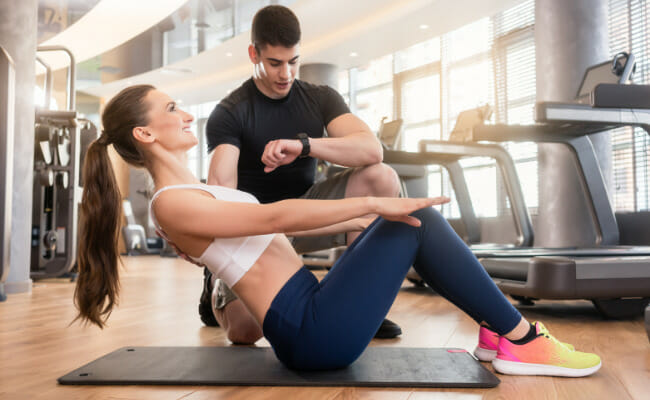Waist Trainers: Do They Really Work?
Waist trainers are corset-like clothing. They are said to trim the waistline and help people attain an hourglass shape. However, the question running through our minds is, “Do they work?” Celebrities publishing photographs and passionate endorsements on social media may have contributed to the waist trainer trend.
Although celebrities swear by them, this does not always imply that they are helpful or safe to use. Before using a waist trainer, it is crucial to realize that the equipment is not always safe or effective. Please continue reading about waist trainers, including their apparent benefits and potential hazards.
What Exactly Is A Waist Trainer?

A waist trainer is a type of underwear comprised of thick fabric and firm metal boning. It’s fastened around the midriff with a lacing system, hooks, or Velcro. It’s meant to be worn considerably tighter than a girdle or shaping undergarments to give you a sleeker, smaller waist. While the benefits are immediately visible, “training” requires wearing the garment for months.
Corsets have been worn for at least 500 years. Initially, they concealed most of a woman’s figure between her breasts and hips. Corsets emerged in the 1800s to highlight the feminine body, striving for the desirable hourglass figure that requires a tiny waist and voluptuous hips. Corsets lost popularity as the desired tiny waist size grew smaller due to discomfort and health issues.
Do They Have Any Effect?
Waist trainers function similarly to corsets, which became unpopular owing to pain and health concerns. A waist trainer can create a temporary reduction in waist size or circumference, and you can see the benefits right away. However, after they remove the waist trainer, their waist will no longer appear smaller.
Furthermore, waist trainers do not decrease body fat. People who want to shed fat around their waistline or drop a significant weight should not rely on waist trainers. However, a person may notice a decreased appetite when wearing a waist trainer. The garment presses on the stomach, giving the wearer a fictitious feeling of fullness.
The Supposed Benefits of Waist Trainers
You may achieve your desired body shape by using a waist trainer. You can use it for weight loss, body toning, and correction of cravings. In addition, some people use waist trainers to reduce back pain while they sit down or sleep.
Trainers also help people with disabilities move more freely and feel more confident when they move. Thus, there are many reasons why people wear waist trainers- for their health, comfort, and appearance. Some of the more noteworthy ones are listed below:
A Figure of An Hourglass
You may train your waist to maintain that shape, and the initial change may be astonishing. The American Board of Cosmetic Surgery website claims that a waist trainer won’t drastically change how your body looks. A waist trainer is unlikely to have a long-term effect even if your body type temporarily lends itself to that form.
Weight Loss
While using a waist trainer, you could drop a fair bit of weight, but it’s more probable that you’ll shed fluid than fat. You could eat less while wearing the trainer since your stomach is restricted. This method of weight loss is neither healthful nor long-lasting.
Even firms that manufacture and sell waist trainers recommend exercise and a nutritious diet as a weight loss strategy. While some waist trainer advocates may advise you to wear your trainer while exercising, this is not a smart idea. It can significantly limit mobility. Furthermore, tissues and muscles require oxygen, particularly during activity.
Decreased Appetite
It seems that having your stomach pinched will make you feel fuller sooner. This condition may cause you to eat fewer calories. Consuming enough nutritious food to be healthy and acquire the necessary vitamins and minerals is critical. Your diet may not be sufficient to keep you healthy if you limit how much you consume.
Better Posture
Wearing a waist trainer may encourage proper posture while you’re wearing it. However, wearing it too often may weaken your core muscles, resulting in back discomfort and bad posture.
Postpartum Support
Waist trainers can help women whose abdominal muscles have stretched or shrunk due to pregnancy. The additional support may assist in alleviating pain and discomfort. Women who wore waist support clothing after a cesarean birth reported less discomfort.
Also, according to research in the International Journal of Gynaecology and Obstetrics, some reported decreased bleeding, and others did not.
Risks of Wearing a Waist Trainer

Photo Credit: Mymed.com
Wearing a waist trainer can be very effective in helping you achieve your weight loss goal. Also, there are many supposed benefits. However, there are some risks involved when wearing a waist trainer.
Trainers can be too restrictive if they’re not large enough or don’t fit well. Before purchasing a waist trainer, it is essential to research your options and make an informed decision about whether or not you will wear one. Below are some risks involved when wearing a waist trainer.
Breathing Difficulties
Wearing a waist trainer might impair your lung capacity by 30 to 60%. It might be unpleasant and drain your vitality. If you cinch it too tightly, you could pass out. It can potentially cause inflammation or fluid accumulation in the lungs. Breathing issues can impact your lymphatic system, which helps your body rid itself of pollutants.
Problems With The Digestive System
When you wear a waist trainer, you are not only compressing skin and fat, but you are also crushing your internal organs. The esophagus, stomach, and intestines are among the organs that you might damage. Pressure can pull acid from your stomach into your esophagus, causing severe heartburn. Wearing a waist trainer may aggravate your gastroesophageal reflux.
Internal Damage
Internal organs like the kidneys and liver are forced into strange positions when you tighten your belly. Organ overcrowding can disrupt blood flow and alter organ function. This condition can eventually lead to chronic organ damage, decreased muscular strength, and even rib fractures.
Is It Safe To Wear Waist Trainers?
Waist training is comparable to fad diets and other fitness fads. It may cause some short waist slimming, but it is not a safe, long-term solution to weight or fat loss. Waist trainers might cause organ damage if used for an extended period. It can also cause digestive problems, such as acid reflux.
Breathing is also made more difficult by waist training. A person may suffer from a lack of oxygen or get quickly winded. As a result, people should not exercise while wearing a corset or waist trainer. If an individual feels lightheaded or short of breath, they should immediately remove the waist trainer.
Alternatives To Waist Trainers
In the short term, waist trainers can help you achieve a thinner-looking waist. Most healthcare specialists believe a healthy diet and regular exercise are the best ways to reduce weight or inches around the waist. There are more nutritional methods to lose weight.
A Well-balanced Diet
Emphasize fresh, healthy meals and portion management. Reduce your sugary snacks and beverages, as well as highly processed meals. The Centers for Disease Control and Prevention CDC recommends the following diet:
- consuming entire grains, fruits, and vegetables, as well as low-fat dairy products
- staying away from added sweets, saturated fats, trans fats, and salt
- consuming more lean meats and protein sources such as fish, vegetables, and nuts
- remaining within the required daily calorie count
Regular Physical Activity
Combine exercise with strength training to tone and strengthen muscles while simultaneously burning calories. You could get help from a personal trainer to create a customized fitness regimen for your unique requirements.
When exercising, a person should focus on aerobic activity, such as jogging or walking, and strength training, such as lifting weights. The American Heart Association (AHA) states that people should engage in 150 minutes of aerobic exercise and activities each week and weight training on at least two days per week.
Shapewear That Is Less Constricting
Invest in undergarments that can help you achieve a slimmer look without restricting your respiration. Some waist cinchers are built with flexible plastic boning for more mobility.
Consult Your Doctor
Ask your doctor for advice on effective weight-loss strategies that won’t harm your health. Individuals should see their doctor before significantly adjusting their diet or exercise routine. An individual’s health can influence the particular recommendations a doctor can offer.
Speak With An Expert
Ask your doctor for a recommendation if there are certain body parts you would like to modify. If diet and exercise fail to help someone lose weight, they might want to speak to their doctor. A physician might be able to suggest further actions or refer them to a dietician or personal trainer.
Conclusion
Waist trainers are unlikely to alter your physique significantly or over the long run. They can potentially create health risks if abused or tightened too tightly. The healthiest and most effective approaches to losing weight and keeping it off include a balanced diet and frequent exercise.
Wearing a waist trainer now and then is unlikely to create difficulties, as long as it is not overly tight. Consult your primary care physician about the safety and efficacy of waist trainers. Always remember that there’s no reason to jeopardize your health for a smaller waist.
Changes in exercise and nutrition are more likely to provide long-term improvements. If you insist on trying them on, choose one that isn’t too tight. If it becomes unpleasant, remove it!





